Decorative variety of honeysuckle Tatarskaya
Tatarian honeysuckle is a popular plant for decorating garden areas. The bushes have a decorative appearance, do not take up much space, and are characterized by a high degree of frost resistance and unpretentiousness. In this article we will talk in detail about the characteristics of the variety, its planting requirements and the nuances of caring for it.
Tatar honeysuckle - description of the variety
Tatar - variety decorative honeysuckle, loved by gardeners due to its unpretentiousness, resistance to frost and the possibility of wide use in landscape design.
Breeding history
There is no data on the exact origin of Tatar honeysuckle, but it is known that it has long been successfully cultivated in Siberia, the Middle Volga region and the Urals. This variety has been grown on private plots and cottages since the 18th century.
According to one theory, the name is due to the wide distribution of this honeysuckle in the territory of Tatarstan, according to another, because it is a variety artificially bred by Tatar breeders.
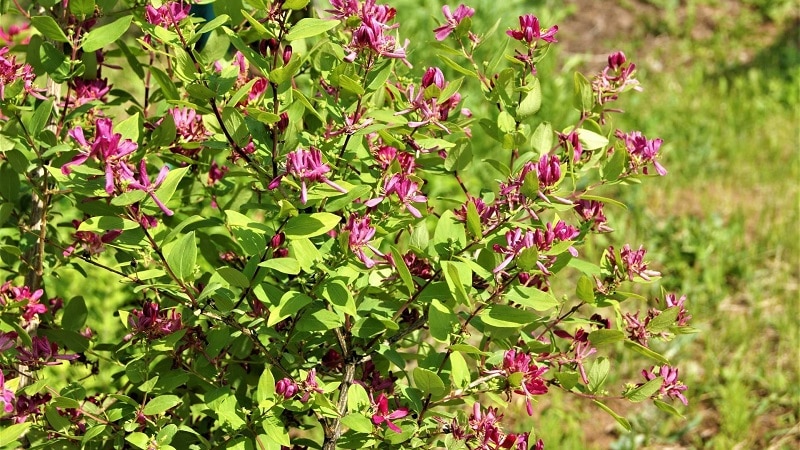
Characteristics, description of appearance
Lonicera tatarica rosea is a tree-like shrub, the size of which depends on growing conditions. Thus, in a wild-growing state, the height reaches 4 m, the crown diameter is 2-2.5 m. In summer cottages, the height does not exceed 3 m with a crown diameter of 1-1.5 m. The shoots are hollow, yellowish-brown in color, and become gray, and the bark on them peels off in longitudinal stripes.
The leaves are small (3-6 cm in length), ovate-oblong, dark green. The surface of the leaf blades is matte; there is a slight bluish coating at the bottom. The flowers are small, reaching 1.8 cm, bell-shaped, pinkish-red in color, two-lipped, with a white or pink corolla.
After flowering, small spherical berries are formed on the bushes, covered with red or yellow-orange skin.
The most famous varieties:
- Arnold Red - leaves are oval-lanceolate, fruits are paired, red;
- Rosea - tall (up to 4 m) bushes with a pyramidal crown, large pink flowers, orange berries;
- Hack Red - purple flowers, dark purple fruits;
- Elegans - flowers with red petals with pink stripes, leaves are small, dark green;
- Zabelii - burgundy flowers, light red berries;
- Morrow (L. morrowii) - bushes 1.5 m high, dark green leaf blades, white flowers, dark red berries.
Features of application
This the variety is inedible, the use of its fruits is possible only in alternative medicine. The main purpose of planting bushes is to decorate the area.
Important! The fruits of all varieties of Tatar honeysuckle contain hydrocyanic acid and should not be eaten.
Tatar honeysuckle - use in landscape design
There are several options for using this honeysuckle variety. in landscape design:
- separate installations - plants are planted one at a time, elastic shoots are tied to trellises, giving the bushes different shapes;
- an element of multi-level compositions - medium-sized varieties of Tatar honeysuckle go well with alpine slides;
- creating hedges - in this case, they start from the height of adult plants: tall bushes are not shortened, medium-sized ones are trimmed to a height of about 1 m, and hedges up to 70 cm high are formed from short ones.
Tall varieties of this variety are also used to decorate and shade facades, arches, arbors or gables.
Reference. Tatar honeysuckle sheds its leaves at the end of autumn, losing some of its decorative properties.
Flowering and ripening time
The bushes begin to bloom 2-3 years after planting. The flowering period lasts about 2 weeks and occurs in May – June. The fruits ripen from July to September, most often reaching full ripening in August.
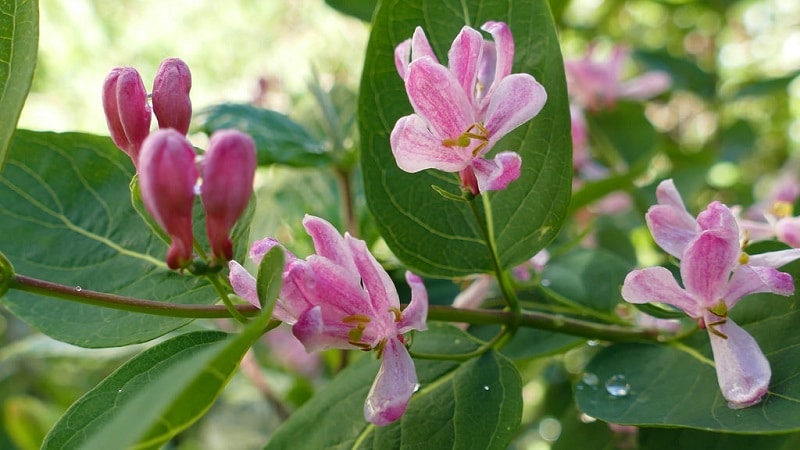
Resistance to diseases and pests
The variety is not resistant to diseases and pests. Of particular danger to it are powdery mildew, cercospora and aphids (in particular honeysuckle-apical and honeysuckle-cereal).
Resistance to cold and drought
Tatar honeysuckle bushes tolerate air temperatures down to -37°C; flowers and leaves do not die in the event of frosts of -8°C.
Plants tolerate short-term drought, while high humidity and waterlogging of the soil lead to the development of fungal diseases and rotting of the root system.
Suitable regions
This variety has a high degree of frost resistance and is able to tolerate short-term drought and other unfavorable weather conditions, so it is successfully grown in all regions.
Advantages and disadvantages
The main advantages of Tatar honeysuckle:
- due to its high decorative qualities, it is excellent for decorating areas;
- plant lifespan is about 15 years;
- various applications in landscape design;
- frost resistance.
The disadvantages of the variety include:
- inedibility of berries;
- short flowering;
- need for good lighting;
- tendency to be affected by fungal diseases;
- the need for regular pruning.
Difference from other varieties and hybrids
Comparison of Tatar honeysuckle with other decorative varieties of culture - in the table:
| Variety | Height of bushes, m | Leaf color | Flower color |
| Tatar | 3-4 | Dark green | Rose red |
| Alberta | 1,2 | Green-blue | Lilac with pink tint |
| Gray | 2 | Green above and bluish-gray below | Yellow with purple or green tints |
| Bedspread | until 3 | Rich green | Lemony, turns purple over time |
Agricultural technology
In order for Tatar honeysuckle to maximize its positive qualities, it is necessary to provide the plants with suitable conditions for growth: choose the optimal time and place of planting and properly care for the bushes.
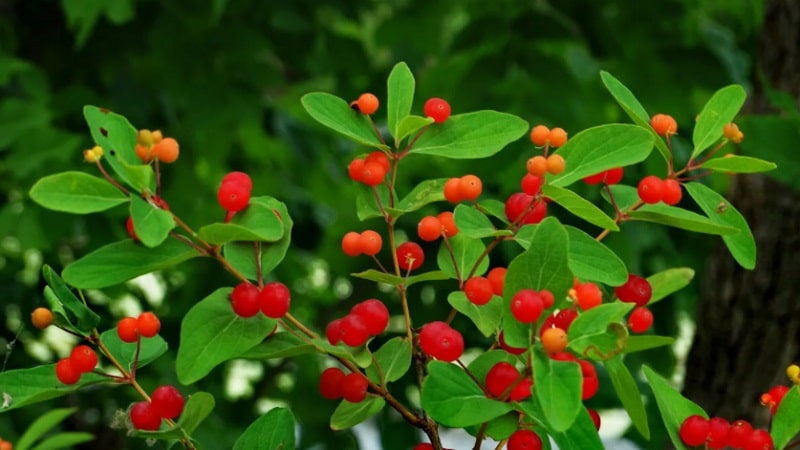
Choosing a place in the garden and preparing holes
Tatar honeysuckle is planted in a well-lit, sun-warmed place. When grown in the shade, the leaves become less bright, the flowers become small and faded, and as a result the bushes lose their decorative appearance.
When choosing a location, the depth of groundwater is also taken into account. The permissible level is 1 m. Growing bushes on swampy soil provokes the development of fungal diseases and rotting of the roots.
Preparing for landing
Planting material is purchased from specialized nurseries. When purchasing, preference is given to 2-3-year-old seedlings 30-50 cm high with 3-4 branches 30-40 cm long.
Plants should have a healthy and developed root system without signs of disease or rot with 2-3 branches with a fibrous network, elastic shoots with 5-12 green buds, smooth bark without damage.
Reference. Peeling of the bark is a characteristic feature of the culture.
Soil requirements
The soil must be fertile, light and loose, have good aeration and moisture permeability, optimal acidity level - pH 7.5-8.5.
Dates, scheme and rules of planting
Seedlings with a closed root system planted in a permanent place throughout the growing season, with open - at the end of September, in cool weather, but at an air temperature not lower than +10°C.
Planting pattern:
- In the selected area, dig planting holes measuring 40x40 cm.
- At the bottom of each, lay 10-15 cm of drainage made of expanded clay, broken brick or crushed stone.
- On top of the drainage layer, pour a nutrient soil mixture (fertile soil, humus or peat and river sand in a ratio of 3:1:1), 1 kg of ash and 50 g of superphosphate.
- Place the seedlings in the holes using the transfer method and cover them with soil so that the tillering unit is flush with the surface.
- Sprinkle the tree trunk circle with ash and mulch with peat, humus, sawdust or hay.
The distance between rows should be 1.5-2 m, between bushes - at least 50 cm.
Features of cultivation
Young plants are watered daily during the first month, then no more than once a week, depending on weather conditions and soil conditions. It should not be overdried or overly moisturized. Honeysuckle aged 2 years and older is watered 2-3 times per season, 10 liters per bush.
After watering, the soil is loosened to a depth of 15-20 cm and the tree trunk circle is mulched with peat or sawdust.
Reference. In autumn and spring, mulch helps retain moisture and maintain optimal temperature.
They begin to feed the bushes 2-3 years after planting.
Fertilizers are applied according to the following scheme:
- before the buds protrude - nitrogen-containing fertilizers (20-30 g per 1 sq. m);
- before flowering - complex mineral preparations (for example, 20 g of Kemira-universal per 10 liters of water);
- in the fall, when digging up the site - wood ash (200 g per 1 sq. m).
Starting from the age of 6, sanitary pruning of bushes is carried out annually in the spring. Remove all damaged, frozen, dry shoots growing close to the ground, shorten the branches, cutting off the tops to the ovaries of flower buds. Formative pruning is carried out throughout the season.
Every 3-5 years bushes rejuvenate, leaving a bare trunk and removing all branches so that shoots 10-20 cm high above the ground remain.
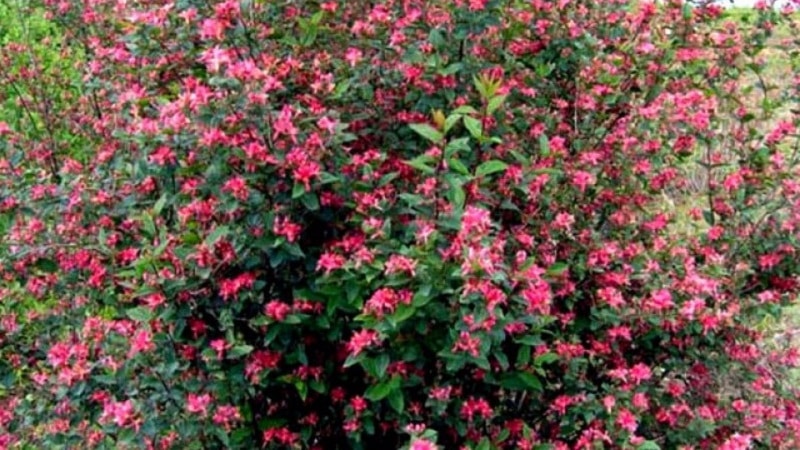
Pollinators
Since it is an inedible variety, yield is not important. Nevertheless, the berries decorate the bushes and give them additional decorative value.
For fruit to appear, Tatar honeysuckle needs cross pollinationTherefore, it is recommended to plant 2-3 varieties of crops on the site at once.
Reference. Fruit ovaries are also guaranteed by the apiary located nearby.
Disease and pest control
Tatarian honeysuckle is susceptible to the following diseases and pests:
| Disease/pest | Signs | Treatment/prevention |
| Powdery mildew | White coating and brown spots on leaves and shoots, drying out of the tops of branches | Damaged shoots are cut off and burned, the bushes are sprayed several times with Topaz or Ordan. |
| Cercospora | Dark green spots on leaves that eventually turn gray with burgundy edges | The leaves are torn off and burned, the plants are sprayed with Bordeaux mixture, “Fundazol” or a solution of soap and copper sulfate. |
| Aphid | Leaves and branch tips dry out and curl | Before the buds awaken, the bushes are sprayed with “Aktellik”, and during the season with “Aktara”. |
Preparing for winter
When grown in central Russia, only young bushes at the age of 1-2 years are covered with spruce branches for the winter. Older plants need additional covering with agrofibre only in the northern regions, provided the air temperature drops below -35...-37°C.
Reproduction
This variety of honeysuckle propagated by cuttings, layering and seeds.
When cuttings, annual (summer) or lignified (autumn) shoots are cut from bushes, cut into 10 cm long pieces and placed in a sand-peat substrate at an angle of 45°, pre-treated with a growth stimulant (Kornevin, Heteroauxin). The container with the cuttings is covered with plastic film to create a greenhouse effect, and after the first leaves appear, it is covered with spruce branches. In spring, rooted plants are planted in a permanent place.
3-4 year old bushes are suitable for propagation by layering. The lower healthy and strong shoots are tilted towards the ground so that the buds touch its surface, fixed with a bracket or pin and sprinkled with soil. Successful rooting is indicated by the appearance of third-party, vertically growing shoots. Next spring, the young seedling is separated from the donor bush and planted in a permanent place.
When sown during the period of fruit ripening, the seeds germinate and form a crown of 3-4 leaves by winter. They are covered during the frost period, and in the spring they continue to grow. If you sow planting material in October - November, germination occurs in the spring.
Reference. When using your own seeds rather than purchased ones, the grown plant may lose its parental characteristics.
Difficulties in growing
Problems that may arise when growing Tatarian honeysuckle:
- the flowers on the bushes are too small, the leaves are pale - the bushes do not have enough light;
- plants slow down in development, wither - the most likely reason is planting bushes in lowlands or excessive watering, which leads to rotting of the roots;
- honeysuckle freezes in winter, despite its frost resistance, the bushes shed their inflorescences - the autumn pruning was done too late, the plants did not have time to get stronger.
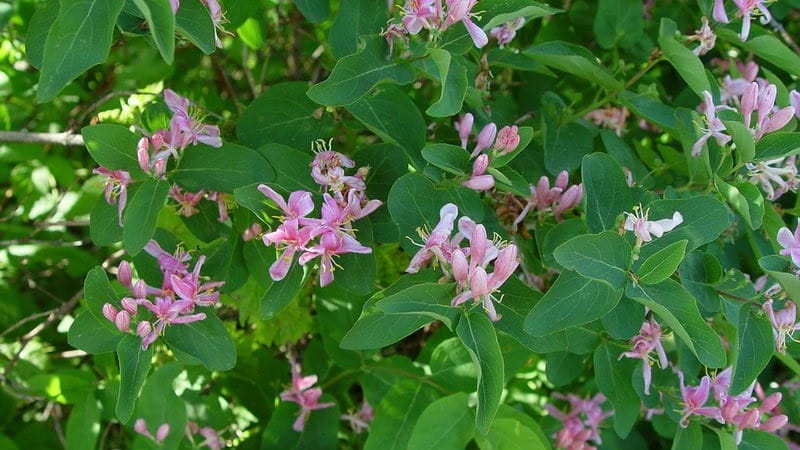
Tips and reviews from experienced gardeners
Experienced gardeners recommend:
- In order for the bushes of this honeysuckle to benefit beekeepers, plant them next to the apiary;
- for planting Tatarskaya, choose well-lit places - the bushes tolerate shade, but because of it the leaves lose their brightness, which negatively affects the decorativeness of the plants.
They respond positively to this variety of honeysuckle.
Lydia, Omsk: “I have 3 bushes growing on my plot, they are already more than 10 years old. Yes, the berries of Tatar honeysuckle are inedible, but they bloom very beautifully and decorate the area. The bushes look especially impressive in the evening.”.
Margarita, Bryansk region.: “I saw beautiful bushes among my neighbors and wanted to plant the same ones on my property. The neighbors shared the seedlings, and in the end 10 out of 10 took root. Incredibly beautiful flowering, you can’t stop looking at it. At the same time, the bushes are very hardy and unpretentious. I practically don’t take care of them, I only water them occasionally and prune them, but that’s enough.”.
Conclusion
Tatarskaya is a variety of decorative honeysuckle, characterized by long plant life, frost resistance, ease of care and the possibility of various uses in landscape design. Among the disadvantages of the variety are the inedibility of the berries, a short flowering period, a tendency to fungal diseases, the need for good lighting and regular pruning.